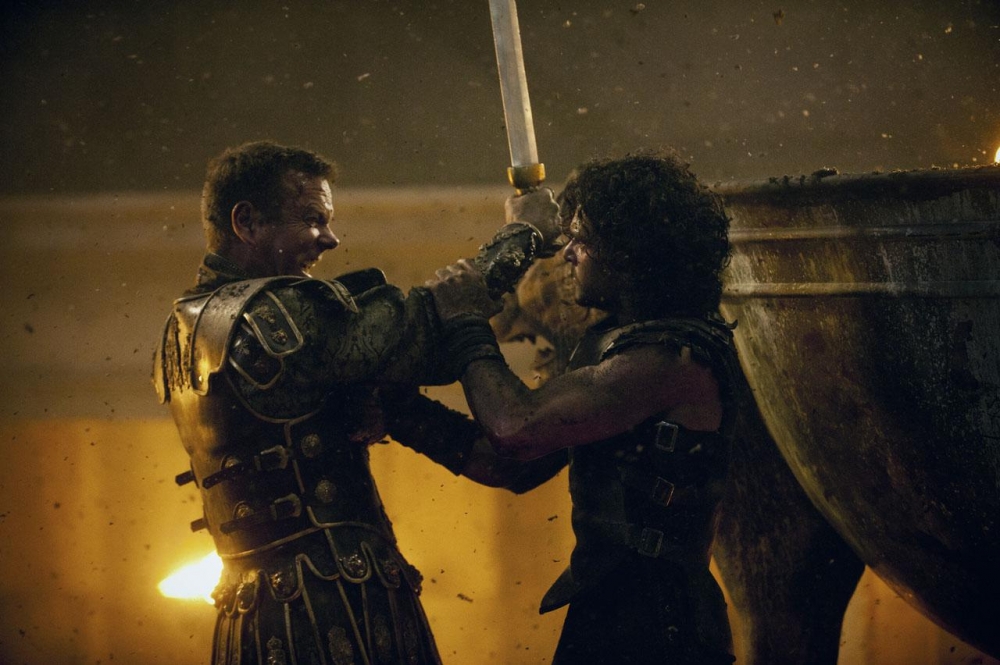By Michael Scoular (The Cascade) – Email
Print Edition: February 26, 2014
If the Resident Evil series is Paul W.S. Anderson in full, ridiculous force, his in-between works are similarly remixed works of cultural bits and technological pieces, though in a lower key. With Pompeii, that means his most sentimental, measured work. Though it opens with a quote from Pliny the Younger’s account of the eruption of Mount Vesuvius, Pompeii is a movie of nods, not lessons, in service of human history. Pompeii deviates from earlier visits to the scene in film history (most working from or paying lip service to Edward Bulwer-Lytton’s The Last Days of Pompeii), and mostly strikes from the familiar remove of Anderson’s eager aesthetic, the Italian romantic tragedy to The Three Musketeers’ French farce.
Opening in extreme close-up on the ash-encased figures that have become the site’s lasting markers, then establishing the presence of Vesuvius’ shadow, Pompeii isn’t a will-they-or-won’t-they scenario. Although the film opens with a different quote from Pliny, at its best Pompeii is an effective lead-in to the dread evoked in another of his account’s passages: “I might boast that, during all this scene of horror, not a sigh, or expression of fear, escaped me, had not my support been grounded in that miserable, though mighty, consolation, that all mankind were involved in the same calamity, and that I was perishing with the world itself.”
Pompeii meshes together three narratives: a Spartacus-like scenario where gladiator-trained slaves bond over boasting talk and glare at guards, an innocent love-at-first-sight saga, and an expansion of the Roman empire that meets public opposition, all overlaid with the knowledge each is equally doomed to insignificance.
Pompeii is Anderson’s fourth movie in a row shot in 3D with cinematographer Glen MacPherson. They’re outliers, in that they use the technology for effects beyond “objects x, y, and z flying at the screen.” Early countryside details are divided into layers, like if Daguerre had been around in 79 A.D. to diorama Roman slavery, and close-ups suggest Anderson cares a little bit about that Sunset Boulevard quote about faces. It’s unlikely anyone will remember a line from Pompeii, but the visual details tell another story. Anderson, who is not a great director of actors (Kit Harrington, Emily Browning, Jared Harris et al. do a fair job with an unexceptional script here), is a great director of models: he knows how to cast light, figures, and effects. The real interest with Pompeii might be the spectacle that’s waiting to erupt, but Anderson isn’t someone who is more comfortable with CG than actors: while he doesn’t have a Milla Jovovich or Christoph Waltz to frame against a modernist or neo-classical backdrop, he creates some carefully exacting portraits out of moonlight, raining ash, and aerial points-of-view.
When it comes to the action in Pompeii, Anderson’s preferred mode of rapid cuts through short-swords and fists for the pre-disaster arena and followed fireball trajectories afterward suggest a lack of imagination — it’s the kind of thing Anderson can do, by now, easily, and isn’t that different from the staging in other war and siege epics. For all the effectiveness of the hellfire and world-crumbling that awaits, the stadium scene just before the earth announces its turmoil is the best scene Anderson pulls off in the film. Not unlike his father’s role in The Hunger Games (or his own turn in the apocalyptic Melancholia), Kiefer Sutherland presides over a give-the-people-the-bloodletting-they-apparently-want panem et circenses routine. Entertainment is mixed with dread (the mountain, and the fate of the two lovers — one being muscled into a political marriage, the other into the gladitorial ring). As Sutherland jokingly puts it, “this isn’t sport; it’s politics.” The action, theatrically set up by a chorus, is a restaging of Rome’s conquest of the British Celts — Sutherland’s character’s best-recorded victory. Anderson is not a director of abstract ideas, but in this dramatic irony pile-up, there’s something of what the rest of Pompeii could have been: not simply cathartic (or, at points, cheap) fear, but cruel humour with a historical sense of purpose.


